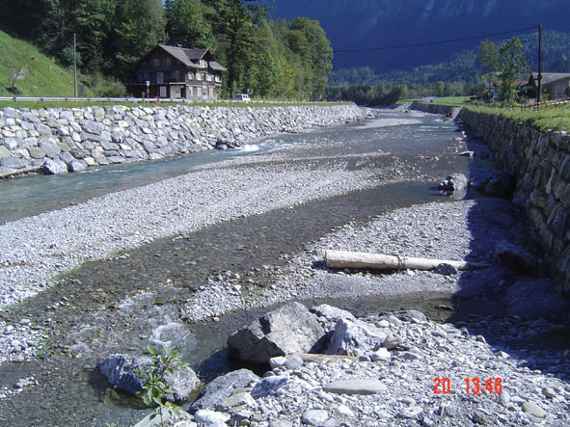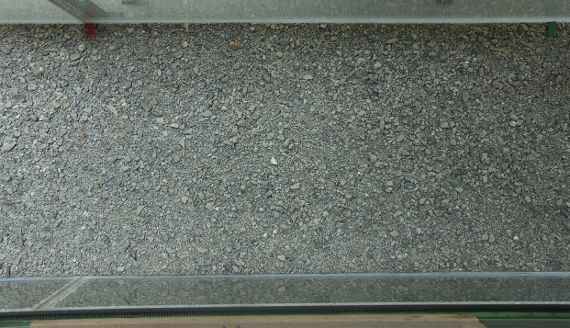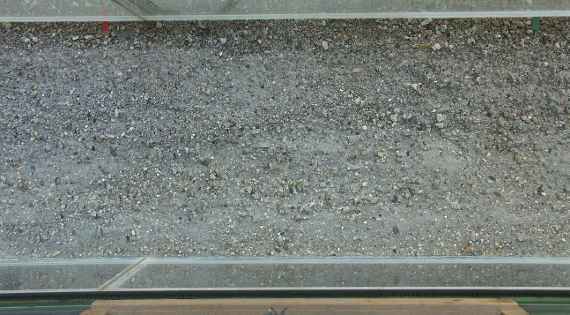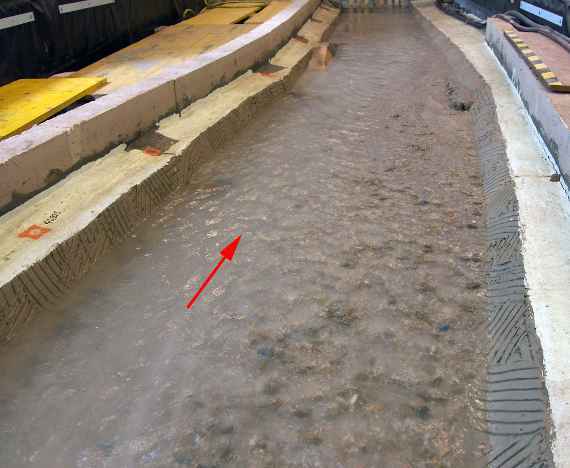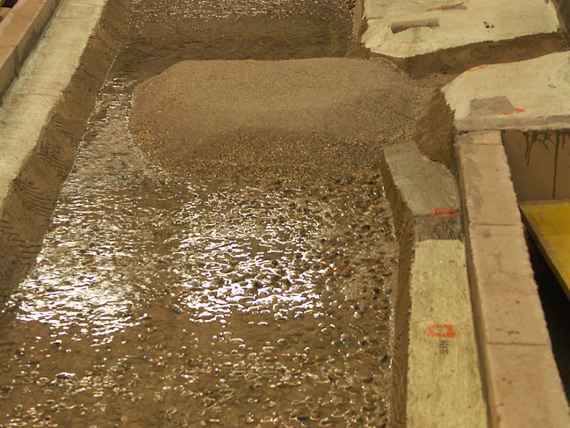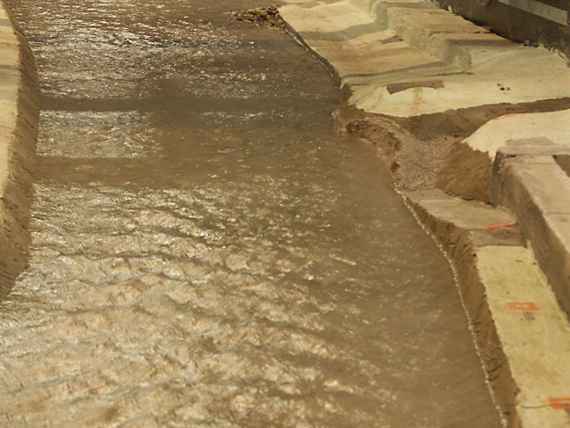For the flood protection of Mellau at the river Bregenzerach a river bed deepening was carried out. The resulting higher bed slope of about 1.3 % required an extensive stabilization of the whole river bed. Within the framework of the model test, two different variants were investigated - a loose riprap and, as an alternative, a coarse-grain enrichment.
CUSTOMER: Office of the Vorarlberg State Government
In the course of the flood protection measures on the river Bregenzerach, a river bed deepening of up to 2 m was carried out in the Mellau municipal area, extending from km 40.85 to 41.25. This measure resulted in a significantly steeper river bed slope of 1.3 % than the estimated equilibrium slope (up to 0.95 %), which meant that a sustainable river bed erosion process was to expect. In order to counteract this erosion trend, a stabilization of the whole river bed was necessary, whereby two measures were possible: a loose riprap or a coarse-grain enrichment of the river bed. For either measure there is no practical experience in this range of slope, especially as the design formulae for loose riprap were also derived for considerably smaller river bed gradients (up to a maximum of 0.2 %). Coarse-grain enrichment would also be a completely new measure, which has, so far only been tested in a model test for the Danube between Vienna and Hainburg (bed slope 0.04 %).
The flood protection measure on the Bregenzerach also affected the Dürrenbach confluence, which was lowered by around 1.2 m. The effects on a loose riprap or an artificially created surface layer, caused by a laterally flowing torrent cannot be estimated mathematically according to the current state of the art. A locally high impulse inflow and a high bed load impact into the Bregenzerach drastically increase the hydraulic load on the river bed protection measure. Both the high impulse inflow of the torrent and the possibly partial relocation of the Bregenzerach due to laterally introduced bed load can lead to premature mobilization of parts of the bed protection in the Bregenzerach, which ultimately causes a failure of the bed stabilizing measures in the worst case. For these reasons, we checked and optimized the planned measures in physical model tests with regard to their feasibility.
While certain empirical values were already available for the loose riprap variant, at least for shallower river bed slopes, on which it was possible to build on, the coarse-grain enrichment variant represented uncharted territory. This solution would have the advantage that certain grain fractions of the bed material, directly available in the Bregenzerach could possibly be used in the implementation, which would result in lower implementation costs.
The physical model test should therefore clarify the following questions:
- Optimization of the stone sizes and the density of occupancy (for example number of stones per square meter) for a loose riprap which remains sufficiently stable and whose stones do not sink slowly into the ground by washing out the bed in the event of flooding.
- Examination of the bed stabilizing effect of this measure in the case of a lateral inflow of a bed load carrying torrent, examination of the failure mechanism and, if necessary, optimization of the measure if the full model shows a lack of bed stability.
- Optimization of the stone sizes and addition quantities for a coarse grain enrichment of the surface layer as well as optimization of the layer thickness. Examination of the change in the coarsened surface layer during bed load transport in the Bregenzerach and examination of the bed stabilizing effect of this measure at the lateral confluence of a bed load carrying torrent. Examination of the failure mechanism and, if necessary, optimization of the measure if a lack of bed stability is found in the full model.
We carried out these tests in a sectional model (length 10 m) and in a full model (length 23 m). The former was intended to clarify the question of the optimal stone size and the number of stones, needed per square meter. The latter was intended to check the stability of the optimized stone layer under the heterogeneous flow situation caused by watercourse curvature, groynes, etc. and the effect of the measure at the lateral confluence of a bed load carrying torrent. The tests were carried out on a scale of 1 to 40.
Ground plan of the full model with loose riprap
Results of the tests
1. The coarse grain enrichment of the river bed, produced from the coarsest grain fractions of the locally available bed material (dm, natural = 180 mm), proved to be insufficiently stable even in the sectional model. The coarse grain overlay of the bed surface led to failure even before an HQ30. In the full model, the far more heterogeneous flow structure with high local turbulence caused the coarse grain layer to rupture already at HQ5 and subsequently a massive channel formation starting from the local defects, which led to a general failure of the coarse grain layer. The coarse grain overlay variant therefore had to be rejected as a bottom stabilizing measure.
River bed before test start
River bed after 260 m³/s (< HQ30); coarse grain overlay is largely removed
2. The loose riprap was constructed with class III stones (0.5 to 0.7 m) with an occupation density of around 30 %. In the transition area downstream of the lowered connecting section, this was reduced to 15 %. The loose riprap proved to be stable over large areas essentially up to HQ300.
Discharge HQ2 after a HQ300 - Current concentration on the left bank caused by erosion downstream
The tests clearly showed that the river bed must be covered with the loose riprap over the entire width of the channel up to the bank protection. Even areas that were not so strongly exposed to the current, such as areas near the bank in groyne fields, had to be covered with the revetment, as unprotected areas immediately led to erosion, which ate into the bed like channels.
3. In order to simulate a lateral bed load impact, caused by the Dürrenbach, and the subsequent increased hydraulic load on the open revetment, bed load of around 7,500 m³ (average annual bed load of the Dürrenbach) was applied to the bed. This material blocked 90 % of the river's width and was loaded with a HQ100 wave.
Bed load impact Dürrenbach at the beginning of the experiment
Bed load impact Dürrenbach at the end of the experiment (view against flow direction)
At the beginning of the HQ100-flood the discharge set in the narrow remaining channel some of the riprap stones in motion, but did not cause extensive failure of the revetment. In the course of the flood, the channel became increasingly wider due to erosion of the bed load impact, so that the hydraulic load on the revetment also decreased continuously and remained stable.
Based on the tests carried out, the loose riprap can therefore recommended as a suitable method for securely fixing the planned stabilization section of the Bregenzerache. This securing method can be used for a slope of 1.3 %. The main advantages of this method are:
- hydraulically fully effective,
- in case of overload only very slowly progressing erosion,
- low material requirement,
- ecological advantages, because the continuity of the bed is maintained.

